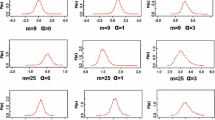Abstract
In this paper, a certain bivariate exponential distribution is used for the spatial prediction. The unobserved random variable is predicted by the projection onto the space of all linear combinations of the powers, up to degree m, of the observed random variables plus the constant 1. We obtain a solution by assuming that all the bivariate distributions follow Gumbel’s type III or logistic form of bivariate exponential. The method is implemented on two data sets and the results are presented. The predictions are compared with the original values through Mean Structural Similarity (MSSIM) index of Wang et al. (IEEE Trans Image Process 13(4):600–612, 2004). Using the MSSIM index the proposed method is also compared with Ordinary Kriging and with Simple Kriging after normal score transform.






Similar content being viewed by others
References
Armstrong M, Matheron G (1986a) Disjunctive kriging revisited: part I. Math Geo 18(8):711–728
Armstrong M, Matheron G (1986b) Disjunctive kriging revisited: part II. Math Geo 18(8):729–742
Ashkar F, El Jabi N, Issa M (1998) A bivariate analysis of the volume and duration of low-flow events. Stoch Hydrol Hydraul 12:97–116
Brockwell PJ, Davis RA (1987) Time series : theory and methods. Springer, New-York
Coles S (2001) An introduction to statistical modeling of extreme values. Springer, London
Cressie N (1991) Statistics for spatial data. Wiley, New York
Downton F (1970) Bivariate exponential distributions in reliability theory. J R Statist Soc B 32:408–417
Efron B (1982) The jackknife, the bootstrap and, other resampling plans. Society of Industrial and Applied Mathematics, CBMS-NSF Monograph 38, SIAM, Philadelphia
Gumbel EJ (1960) Bivariate exponential distributions. J Am Stat Assoc 55:689–707
Isaaks EH, Srivastava RM (1989) An introduction to applied geostatistics. Oxford University Press, New York
Journel AG (1977) Kriging in terms of projections. Math Geo 9(6):563–586
Journel AG, Huijbregts CHJ (1978) Mining geostatistics. Academic Press, London
Lu JC, Bhattacharyya GK (1991) Inference procedures for a bivariate exponential of Gumbel based on life test of component and system. J Stat Plan Inference 27:383–396
Long D, Krzysztofowicz R (1992) Farlie-Gumbel-Morgenstern bivariate densities: are they applicable in hydrology? Stoch Hydrol Hydraul 6:47–54
Long D, Krzysztofowicz R (1995) A family of bivariate densities constructed from marginals. J Am Stat Assoc 90(430):739–746
Marshall AW, Olkin I (1967) A multivariate exponential distribution. J Am Stat Assoc 62:30–44
Matheron G (1976) A simple substitute for conditional expectation: the disjunctive kriging. In: Guarascio M et al (eds) Advanced geostatistics in the mining industry. Proceedings of NATO A.S.I. Reidel & Co., Dordrecht, pp 221–236
Nadarajah S (2007) A bivariate gamma model for drought. Water Resour Res 43:W08501. doi:10.1029/2006WR005641
Nadarajah S (2008) A bivariate pareto distribution. Stoch Environ Res Risk Assess. doi:10.1007/s00477-008-0260-4
Nadarajah S, Gupta AK (2006a) Cherian’s bivariate gamma distribution as a model for drought data. Agrociencia 40:483–490
Nadarajah S, Gupta AK (2006b) Friday and Patil’s bivariate exponential distribution with application to drought data. Water Resour Manage 20:749–759
Nadarajah S, Kotz S (2006) Sums, products, and ratios for Downton’s bivariate exponential distribution. Stoch Environ Res Risk Assess 20:164–170
Pickands J (1981) Multivariate extreme value distributions. Bull Int Stat Inst: 859–878
Schlather M, Tawn JA (2003) A dependence measure for multivariate and spatial extreme values: properties and inference. Biometrika 90(1):139–156
Singh K, Sing VP (1991) Derivation of bivariate probability density functions with exponential marginals. Stoch Hydrol Hydraul 5:55–68
Subramanyam A, Pandalai HS (2004) On the equivalence of the cokriging and kriging systems. Math Geo 36(4):507–523
Tawn JA (1988) Bivariate extreme value theory: models and estimation. Biometrika 75(3):397–415
Wang Z, Bovik AC (2002) A universal image quality index. IEEE Signal Process Lett 9(3):81–84
Wang Z, Bovik AC, Sheikh HR, Simoncelli EP (2004) Image quality assessment: from error visibility to structural similarity. IEEE Trans Image Process 13(4):600–612
Wang Z (2003) The SSIM index for image quality assessment. Online available: www.ece.uwaterloo.ca/˜z70wang/research/ssim/
Yue S (2001a) A bivariate gamma distribution for use in multivariate flood frequency analysis. Hydrol Process 15:1033–1045
Yue S (2001b) Applicability of the Nagao-Kadoya bivariate exponential distribution for modeling two correlated exponentially distributed variates. Stoch Environ Res Risk Assess 15:244–260
Yue S (2001c) A statistical measure of severity of El Niño events. Stoch Environ Res Risk Assess 15:153–172
Yue S, Ouarda TBMJ, Bobée B (2001) A review of bivariate gamma distributions for hydrological application. J Hydrol 246:1–18
Yue S, Wang CY (2004) A comparison of two bivarite extreme value distributions. Stoch Environ Res Risk Assess 18:61–66
Author information
Authors and Affiliations
Corresponding author
Appendices
Appendix 1
Suppose for some monotone function \({\phi}(\cdot),\) such that Y α = ϕ(Z α) has standard normal distribution. Also it is assumed that all bivariate distributions of Y s and Y (s+h) are given by bivariate normal distribution with correlation coefficient ρ h . Now we will show that the projection of the unobserved r.v. Y 0 on to the space \({{\mathcal{P}}}_n^m\) is same as the projection of Y 0 on to the space of all linear combinations of {Y 1, Y 2,…,Y n }. In other words, the predictor obtained by projecting Y 0 on to the space \({{\mathcal{P}}}_n^m\) reduces to the linear form. This does not follow directly from the fact that, the conditional expectation function of the multivariate normal distribution is linear because here, we only assume that all the bivariate distributions are bivariate normal and do not make any assumption on the multivariate distribution of the process {Y s }. To proceed, define the m-dimensional process \(\{{{\mathbf{X}}}_{\varvec{\alpha}}\}\) such that \({{\mathbf{X}}}_{\varvec{\alpha}} = \{Y_{\alpha}, Y_{\alpha}^2, \ldots, Y_{\alpha}^m \}.\) Now we have data at n locations on m-dimensional process X α. Note that X α,i = Y iα . The random variable X α,1 is treated as a primary variable since the estimate of Y 1α is to be sought. The other random variables X α,i for i > 1, are considered as the secondary variables. Autokrigeability condition (see, for example, Subramanyam and Pandalai 2004) states that we can drop all secondary variables from the cokriging equations if the following equation satisfies.
From the bivariate normality of Y α and Y α+h , one can show that
where c i depends only on i and hence independent of lag h. Since Y α is a standard normal variate, \({\rm Cov}(Y_{\alpha}, Y_{\alpha + h }^i) = {{\mathbb{E}}}(Y_{\alpha} Y_{\alpha + h }^i) = c_i \rho_h. \) So the Eq. (A1.1) becomes
Hence all secondary variables i.e. X α,i = Y iα for i > 1, can be dropped from the estimation of Y 0 and thus estimator reduces to the linear form.
Appendix 2
The expectation \({{\mathbb{E}}}(Y_{\alpha}^i Y_{\alpha +h}^j)\) given in the Eq. (7) is derived here. Let (X,Y) follows a bivariate exponential distribution of the Gumbel’s logistic form with the dependence parameter δ. Then the joint survival function is given by the Eq. (7) and the joint density function by
Now consider the transformation,
Note that U ∈ [0,1] and S ∈ [0, ∞). The inverse transform is
The Jacobian of the transformation is
The joint density of the transformed variables (U, S) is given by
where \(h_1(s) = {\rm exp}\{ -s \} \; \delta \; \left[s +({\frac{1} {\delta}} - 1) \right]\) is the marginal distribution of the variable S and h 2(u) = 1 is the marginal distribution of standard Uniform variate U. From the Eq. (A2.1), we can say that the random variables U and S are independent. This implies
Now,
and the second term in the Eq. (A2.2) is
From the Eqs. (A2.2), (A2.3), and (A2.4)
Hence the expectation in the Eq. (7).
Rights and permissions
About this article
Cite this article
Helwade, D.R., Subramanyam, A. Spatial prediction using bivariate exponential distribution. Stoch Environ Res Risk Assess 24, 271–281 (2010). https://doi.org/10.1007/s00477-009-0316-0
Published:
Issue Date:
DOI: https://doi.org/10.1007/s00477-009-0316-0




